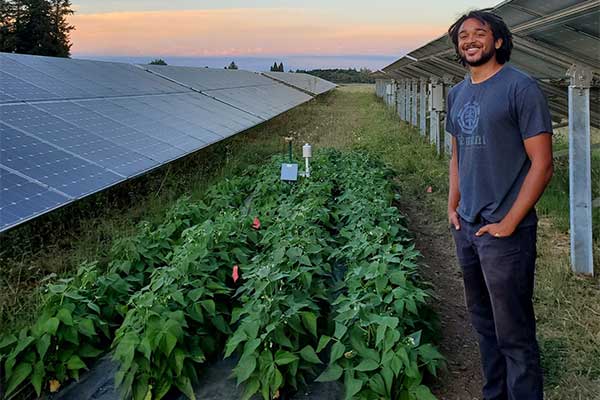- Wide-scale installation of agrivoltaic systems could lead to an annual reduction of 330,000 tons of carbon dioxide emissions in the U.S.
- Oregon State University researchers say co-locating solar and agriculture could provide 20 percent of U.S electricity generation.
- Using an investment of less than 1 percent of the annual U.S budget.
Co-developing land for both solar photovoltaic power and agriculture could provide 20 percent of total electricity generation in the United States with an investment of less than 1 percent of the annual U.S. budget, a new paper by Oregon State University researchers found.
Wide-scale installation of agrivoltaic systems could lead to an annual reduction of 330,000 tons of carbon dioxide emissions in the U.S — the equivalent of 75,000 cars off the road per year — and the creation of more than 100,000 jobs in rural communities, while minimally impacting crop yield, the researchers say.
“Agrivoltaics provide a rare chance for true synergy: more food, more energy, lower water demand, lower carbon emissions, and more prosperous rural communities,” said Chad Higgins, an associate professor in Oregon State’s College of Agricultural Sciences and the senior author of the paper published in the journal Sustainability.
Agrivoltaics also align with the goals of the Green New Deal, a package of federal legislation that seeks to address climate change and economic inequalities, Higgins said.
“Rural America, agriculture in particular, can be the solution to many of our concerns, whether it be renewable energy, mitigating climate change impacts, sustainable food or good water resource management,” Higgins said. “That connection is untapped mostly because there hasn’t been sufficient investment in those communities.
“What we propose in this paper is all possible. It’s technically possible. It’s politically possible. And it would make money after the initial investment. That’s the takeaway — that we should take a hard look at agriculture as a solution to problems rather than a cause of problems.”
The analysis outlined in the paper prepares Higgins for the next phase of his agrivoltaics research, which includes the installation of a fully functional solar farm designed to prioritize agricultural activities on five acres of Oregon State’s North Willamette Research and Extension Station in Aurora, Oregon, 20 miles south of Portland.
The next phase aims to demonstrate to the agricultural community and potential future funders how Higgins’s findings can be applied in real-world agricultural systems to encourage early adoption. Ground is expected to be broken in May 2021 with production expected to start in 2022.
In the Sustainability paper, Higgins and his co-author, Kyle Proctor, a doctoral student in his lab, find that an area about the size of Maryland would be needed for agrivoltaics to meet 20 percent of U.S. electricity generation. That’s about 13,000 square miles, or 1 percent of current U.S. farmland.
The cost of the agrivoltaic arrays would be $1.12 trillion over a 35-year project life. The researchers believe that the private sector would invest in the bulk of the construction costs with the federal government contributing with rebates and other incentives.
Using money generated from the electricity the arrays produce, the researchers estimate it would take about 17 years to payback the $1.12 trillion. After the projected 35-year lifespan of the project, the researchers estimate the arrays would produce $35.7 billion in revenue.
Installation of the arrays would create the equivalent of 117,000 jobs lasting 20 years, with 40 percent being sustainable positions for operating and maintaining the arrays, the researchers say.
Higgins comes at this project with an eclectic background. He went through a self-described engineering degree collection phase and has published papers on everything from enzyme reaction kinetics to snow physics to turbulence theory.
The broad background came in handy one day in 2013 while he was strolling his “thinking walk path” on the Oregon State campus. He noticed greener pasture under recently installed solar arrays. Drawing on his background studying water, agriculture, renewable energy, mechanical and civil engineering, he started thinking about agrivoltaics research.
His initial research focused on the impact solar arrays had on the crops planted around them. That research, along with work by other scientists, has shown that crop yield is dependent on the type of crop, but in the end, when the value of the electricity generated by the solar panels is included, there is an economic net benefit from the agrivoltaic systems.
Looking to the future, Higgins believes the wide-scale installation of agrivoltaic systems opens the door for other technologies. The surplus energy generated by the solar arrays could be used to power electric tractors or to generate fertilizer on a farm. Inexpensive sensors could be installed on the solar panel platforms to support artificial intelligence-based decisions to improve agricultural productivity.
“Once we have infrastructure, once we have energy, we are ready to tackle so many more big problems,” Higgins said.
—-
Publication Referenced in the Article:
Kyle W. Proctor, Ganti S. Murthy, Chad W. Higgins. Agrivoltaics Align with Green New Deal Goals While Supporting Investment in the US’ Rural Economy. Sustainability, 2020; 13 (1): 137 DOI: 10.3390/su13010137










Comments